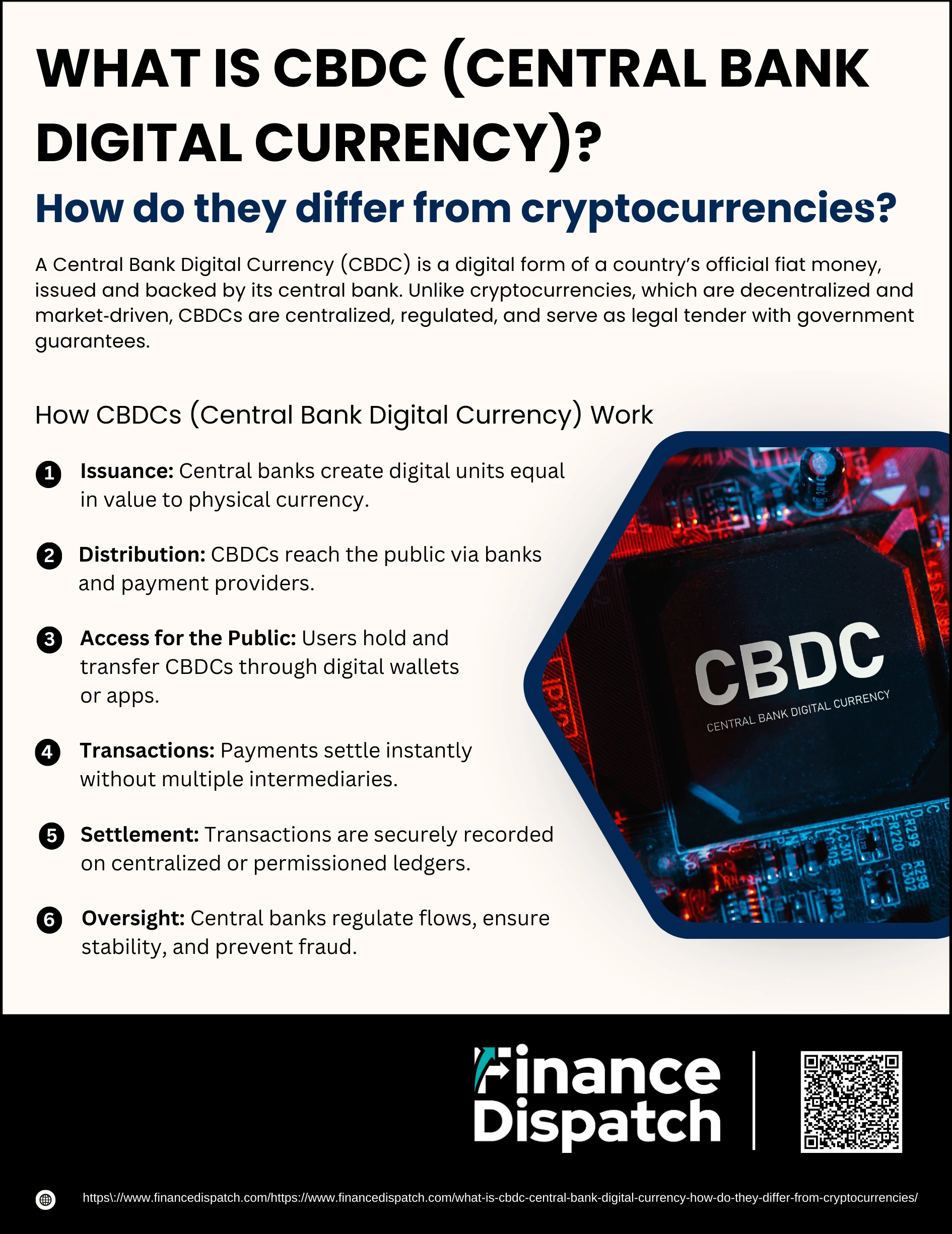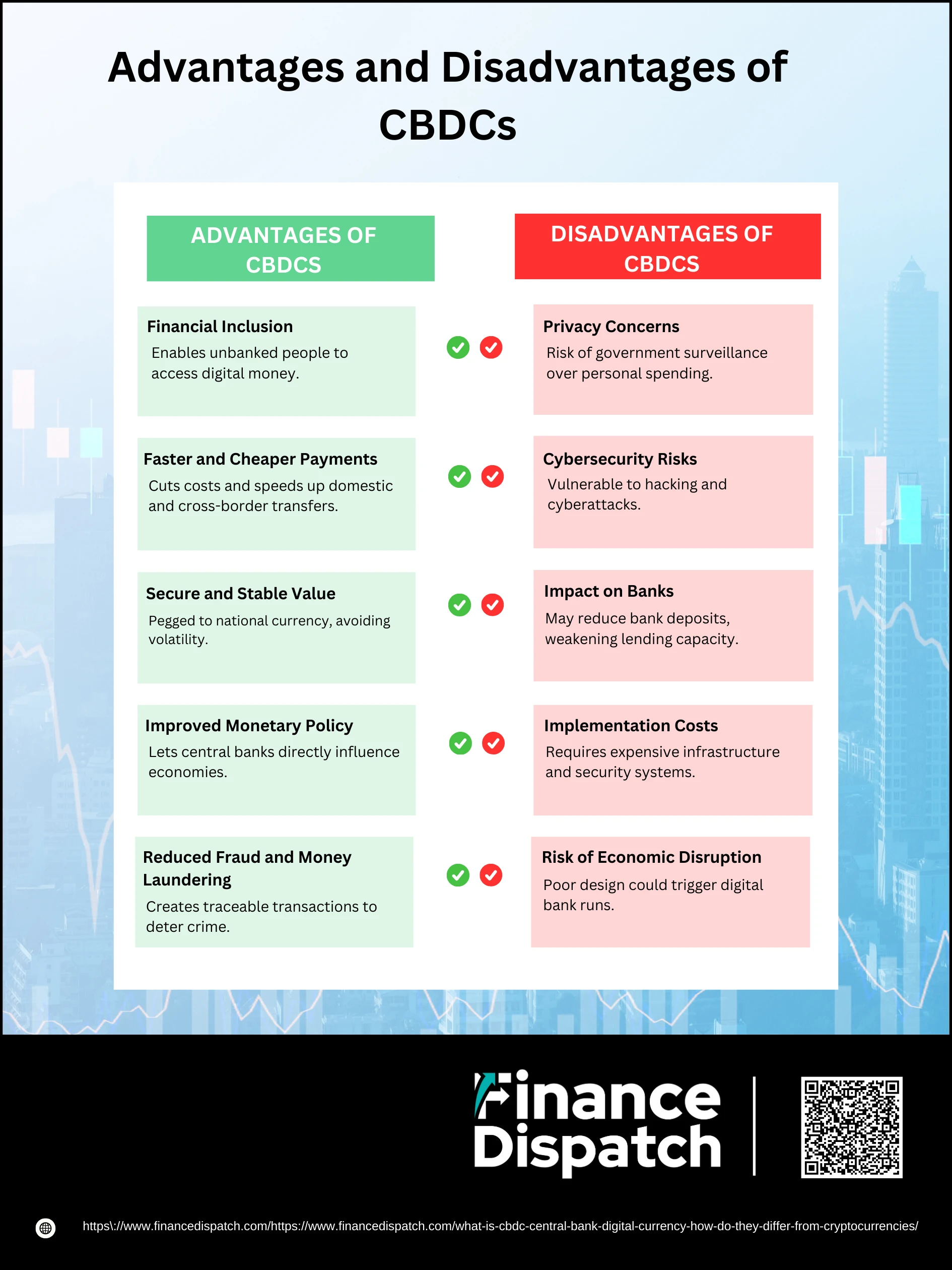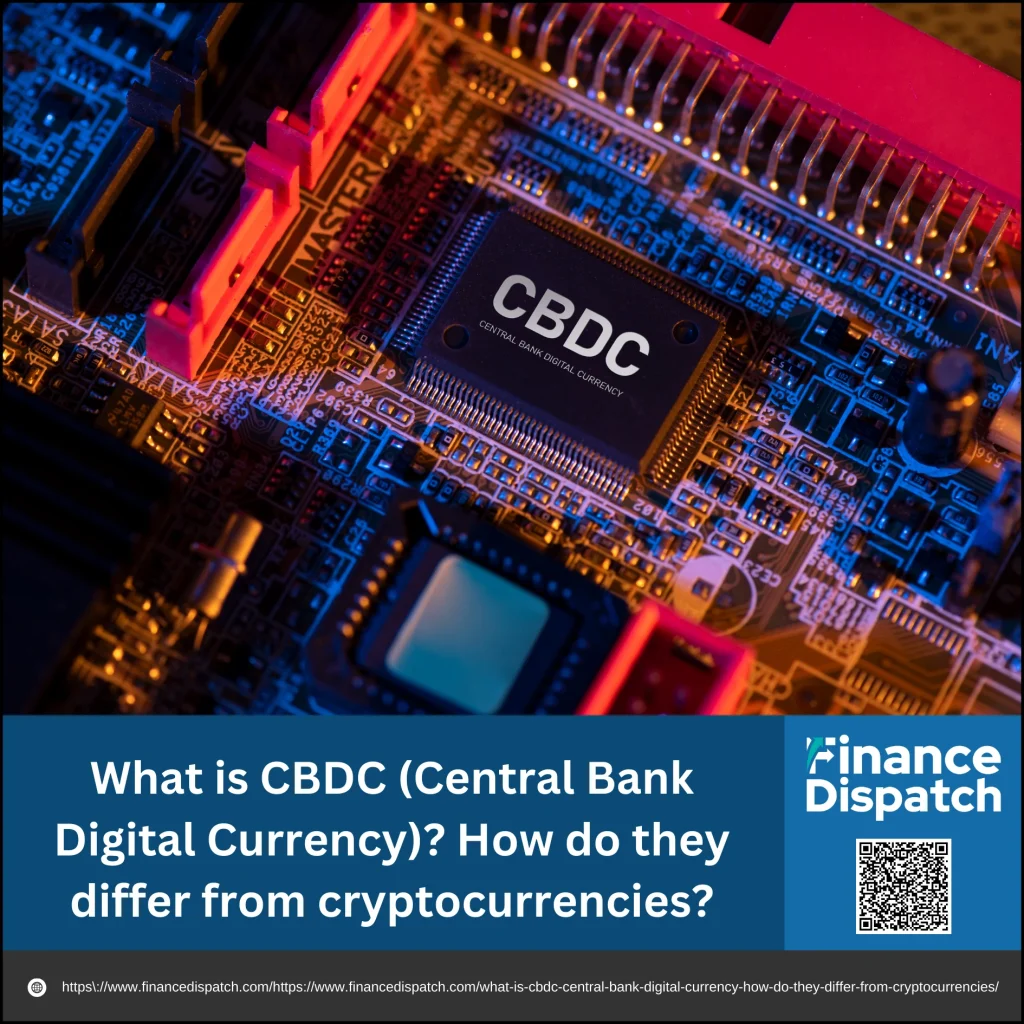Money has always evolved with human needs—from bartering goods, to coins and paper notes, and now to the swipe of a card or a tap on a phone. The next step in this journey is the rise of Central Bank Digital Currencies (CBDCs)—digital versions of national money issued and backed by central banks. Unlike cryptocurrencies, which are decentralized and often volatile, CBDCs are designed to be stable, government-guaranteed, and accessible for everyday use. As more countries experiment with these digital currencies, understanding what sets them apart from crypto becomes essential for businesses, consumers, and anyone curious about the future of money.
What is a Central Bank Digital Currency (CBDC)?
A Central Bank Digital Currency (CBDC) is a digital form of a country’s official money, issued and regulated by its central bank. It carries the same value as physical cash or the balance in your bank account but exists purely in electronic form. Unlike cryptocurrencies, which are created and managed on decentralized networks, a CBDC is fully backed by the government and recognized as legal tender. This means that one digital dollar, euro, or yuan issued as a CBDC is always equal in value to its physical counterpart. In practice, CBDCs aim to combine the convenience of digital payments with the safety and trust that come from being directly tied to a nation’s central bank.
 How CBDCs Work
How CBDCs Work
Central Bank Digital Currencies (CBDCs) are designed to function like digital cash, combining the trust of central bank–issued money with the convenience of modern digital payments. Unlike cryptocurrencies, CBDCs don’t fluctuate in value wildly and are recognized as legal tender in their home country. Here’s a deeper look at how they operate:
1. Issuance
The process begins with the central bank creating digital currency units, just like it prints paper notes or mints coins. These units are backed by the government and represent the official national currency in electronic form. For example, $10 in CBDC will always equal $10 in cash.
2. Distribution
Once created, the digital currency isn’t handed directly to the public. Instead, it flows through existing financial channels, such as commercial banks and authorized payment providers. These institutions act as intermediaries, ensuring the CBDCs reach everyday users securely.
3. Access for the Public
Citizens and businesses can access CBDCs through digital wallets or apps provided by banks, fintech firms, or central bank–approved platforms. These wallets act like virtual bank accounts, allowing users to store, send, and receive CBDCs instantly.
4. Transactions
With CBDCs, everyday payments—whether buying groceries, paying bills, or transferring money to a friend—happen digitally. The key advantage is that transactions settle in real time, often within seconds, without relying on multiple intermediaries.
5. Settlement
Each transaction is recorded on a secure ledger. Depending on the design, this could be a centralized database controlled by the central bank or a permissioned distributed ledger. This ensures transparency, prevents double-spending, and guarantees the integrity of the payment system.
6. Oversight
Finally, the central bank plays a supervisory role. It regulates the flow of digital money, enforces rules to prevent fraud and money laundering, and ensures the currency remains stable. This oversight distinguishes CBDCs from cryptocurrencies, which operate without central authority.
Types of CBDCs
Central Bank Digital Currencies (CBDCs) are not one-size-fits-all. Depending on who uses them and how they are designed, CBDCs fall into two main categories: wholesale and retail. Both serve different purposes in the financial system, but together they show how digital currencies could reshape money for institutions, businesses, and everyday people.
1. Wholesale CBDCs
These are primarily designed for banks and large financial institutions. They work much like the reserves that banks already hold at the central bank but in digital form. Wholesale CBDCs can make interbank settlements faster, more secure, and cheaper, especially for cross-border payments between countries.
2. Retail CBDCs
These are created for the general public—individuals and businesses—to use in their daily transactions. Retail CBDCs act like digital cash stored in a wallet or app. They can be structured as:
- Token-based: Verified with digital keys (private/public), allowing transactions with some level of anonymity.
- Account-based: Linked to a digital identity, requiring users to register an account for access.
What are Cryptocurrencies?
Cryptocurrencies are digital or virtual currencies that use cryptography to secure transactions and control the creation of new units. Unlike CBDCs, they are not issued by governments or central banks; instead, they operate on decentralized networks, often using blockchain technology. The first and most well-known cryptocurrency, Bitcoin, was introduced in 2009 as a peer-to-peer system that allows people to transfer value without banks or intermediaries. Other cryptocurrencies, such as Ethereum, Ripple, and thousands more, have since emerged. Their value is largely driven by supply and demand in the market, which makes them highly volatile—capable of rising or falling dramatically within short periods. While they offer innovation, privacy, and freedom from centralized control, they also come with risks like price instability, regulatory uncertainty, and vulnerability to hacking.
CBDC vs Cryptocurrencies: Key Differences
Although both CBDCs and cryptocurrencies exist in digital form, they are fundamentally different in design, purpose, and governance. CBDCs are centralized, government-backed currencies intended to provide stability and trust, while cryptocurrencies are decentralized assets that thrive on open networks and market demand. Understanding these differences is essential to see how each could shape the future of money.
| Feature | CBDCs | Cryptocurrencies |
| Issuer | Central banks (government authority) | Private actors, decentralized networks |
| Legal Status | Recognized as legal tender | Not legal tender in most countries |
| Stability | Pegged 1:1 to national currency, stable in value | Highly volatile, value based on market demand |
| Control | Centralized and regulated by the issuing central bank | Decentralized, no central authority |
| Purpose | Everyday payments, financial inclusion, monetary policy tool | Investment, speculation, alternative transactions |
| Technology | Often built on permissioned blockchain or centralized ledger systems | Built on public, decentralized blockchains |
| Trust Factor | Backed by the government | Based on cryptography and user consensus |
 Advantages and Disadvantages of CBDCs
Advantages and Disadvantages of CBDCs
Central Bank Digital Currencies (CBDCs) are seen as a major innovation in the future of money. They aim to combine the convenience of digital payments with the trust of government-backed currency. However, while the benefits are promising, the risks cannot be ignored. Below is a more detailed look at the advantages and disadvantages of CBDCs.
Advantages
1. Financial Inclusion
Millions of people worldwide still lack access to basic banking services. CBDCs can change this by allowing anyone with a smartphone to hold and transfer digital money without the need for a traditional bank account. This could empower unbanked communities, especially in rural or low-income regions, to participate in the financial system.
2. Faster and Cheaper Payments
CBDCs can streamline transactions by removing intermediaries. Domestic transfers can be completed instantly, while international payments that often take days and incur high fees could happen within seconds. This is particularly helpful for migrant workers sending remittances home.
3. Secure and Stable Value
Unlike cryptocurrencies, which can swing wildly in value, CBDCs are pegged to a nation’s official currency. Since they are backed by central banks, people can trust that their value will remain stable and predictable, much like physical cash.
4. Improved Monetary Policy
CBDCs give central banks a new, direct channel to influence the economy. For example, during a crisis, they could distribute stimulus funds straight into citizens’ digital wallets. This can make monetary policies like adjusting interest rates or curbing inflation more effective and immediate.
5. Reduced Fraud and Money Laundering
Every CBDC transaction leaves a digital trail, making it easier to track and prevent illegal activities such as money laundering, tax evasion, and terrorist financing. The transparency built into the system strengthens financial security.
Disadvantages
1. Privacy Concerns
Because CBDCs are issued and monitored by governments, there are fears they could be used to track people’s spending habits. If not designed with privacy safeguards, CBDCs might allow too much state surveillance over individual financial activity.
2. Cybersecurity Risks
CBDCs are fully digital, which makes them vulnerable to cyberattacks. Hackers targeting central bank systems could disrupt economies, steal data, or undermine public trust. Maintaining robust cybersecurity will require constant vigilance and significant investment.
3. Impact on Banks
If citizens prefer holding CBDCs directly instead of keeping deposits in commercial banks, banks could lose a major source of funds. This “disintermediation” might limit their ability to lend money, potentially destabilizing the banking sector.
4. Implementation Costs
Building the infrastructure for a CBDC—secure servers, digital wallets, identification systems, and cybersecurity measures—is extremely costly. Governments and central banks must weigh these expenses against the potential benefits.
5. Risk of Economic Disruption
Poorly designed CBDCs could cause unintended consequences. For instance, during a financial crisis, people might quickly transfer their funds from banks to CBDC wallets, triggering a digital “bank run.” Such scenarios could strain the central bank’s ability to maintain stability.
Global Developments in CBDCs
Central Bank Digital Currencies are no longer just theoretical ideas. Many countries have moved from research into pilot programs, and some have even launched fully functional digital currencies. These developments reflect the global race to modernize money, improve financial inclusion, and strengthen monetary systems.
1. Bahamas – Sand Dollar: The first fully operational CBDC, launched in 2020, aimed at improving access to financial services across the country’s many islands.
2. Nigeria – eNaira: Introduced in 2021 to expand financial inclusion and reduce the cost of remittances, though adoption has been mixed.
3. China – Digital Yuan (e-CNY): One of the largest and most advanced pilots, already being used in major cities for retail purchases, transit, and government services.
4. Jamaica – JAM-DEX: Rolled out to make digital payments easier and more accessible for citizens without bank accounts.
5. Eastern Caribbean Currency Union – DCash: A regional CBDC pilot designed for multiple Caribbean nations, though it faced technical setbacks before relaunching.
6. European Union – Digital Euro: Still in the research and design phase, planned as a complement to cash with a possible launch later this decade.
7. India – Digital Rupee: Currently under pilot testing for both wholesale and retail use, focusing on improving digital transactions and reducing reliance on cash.
8. United States – Digital Dollar: No official launch yet, but the Federal Reserve is actively studying whether a CBDC could strengthen the existing payment system.
The Future of CBDCs
The future of Central Bank Digital Currencies (CBDCs) will likely be shaped by how well they balance innovation, trust, and regulation. As more countries experiment with pilots and limited rollouts, the focus will be on designing systems that are secure, user-friendly, and respectful of privacy. In the coming years, CBDCs could play a major role in speeding up cross-border payments, widening financial inclusion, and giving central banks stronger tools to stabilize economies. However, their success will depend on addressing challenges such as cybersecurity risks, potential disruption to commercial banks, and concerns over government surveillance. Rather than fully replacing cash or cryptocurrencies, CBDCs are expected to coexist alongside them, forming part of a more diverse and digital financial landscape.
Conclusion
Central Bank Digital Currencies (CBDCs) represent the next stage in the evolution of money, bridging the gap between traditional cash and modern digital finance. Unlike cryptocurrencies, which are decentralized and often volatile, CBDCs are government-backed and designed to offer stability, security, and wider accessibility. While they promise benefits such as faster payments, financial inclusion, and stronger monetary control, they also raise concerns around privacy, cybersecurity, and their impact on banks. As nations continue to test and refine these systems, the future of CBDCs will depend on finding the right balance between innovation and trust. Ultimately, CBDCs, cryptocurrencies, and stablecoins are likely to coexist, shaping a financial world that is more digital, interconnected, and complex than ever before.



